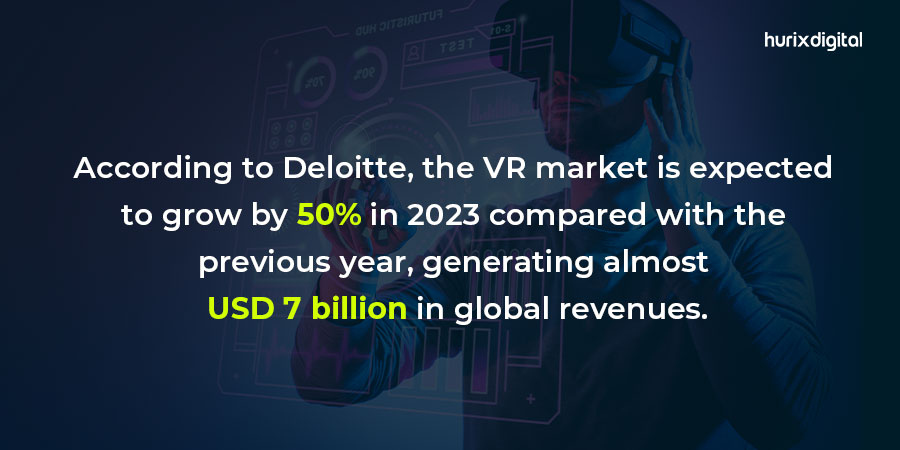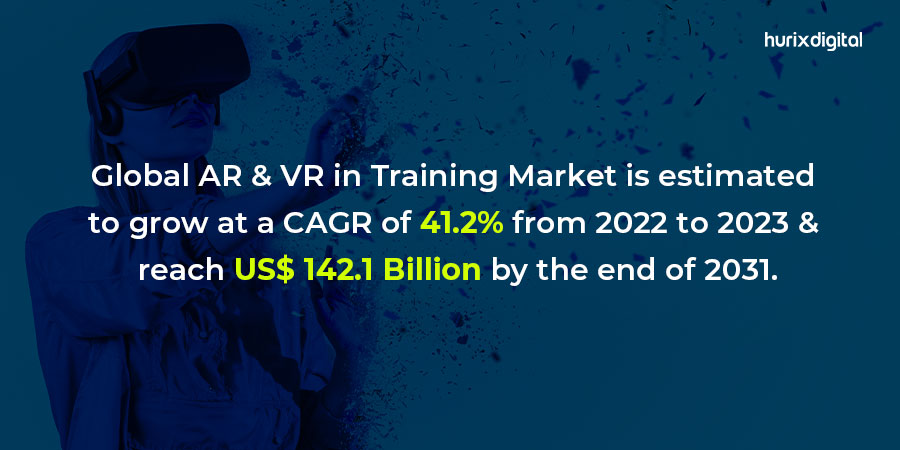7 Benefits of Using AR and VR Technology in Employee Training
Summary
The blog post highlights the advantages of using Augmented Reality (AR) and Virtual Reality (VR) technology in employee training. It discusses how AR/VR simulations create immersive and interactive learning experiences, enhance skill development, improve knowledge retention, and increase employee engagement.
Table of Contents:
The incorporation of VR and AR into learning has created an environment where learners can have a hands-on learning experience. The technologies facilitate learning by doing, even in cases where the approach has been impossible. The market growth of these technologies is impressive. The value of AR in education is expected to reach $5.3 billion by 2023. At the same time, VR in education is predicted to grow to $640 million.
What is AR?
AR or augmented reality is the incorporation of digital information in a video or user environment in real-time. You can use the technology to superimpose sound, videos, images, animations, and more to create a holographic effect.
What is VR?
VR or virtual reality is a technology that creates a virtual environment, putting the user inside the experience. Using VR headsets, viewers can interact and manipulate a 3D world for an experience closer to reality.

Benefits of AR and VR in Employee Training
1. Providing Training in a Safe and Affordable Manner
Some industries need to train their employees in the processes and operations before they assume full responsibility. For instance, employees working in power plants or manufacturing units need to know how to operate machines properly on the site. Unless they get a good knowledge of things, they cannot be allowed to take over. VR and AR can be used to make simulations where training can be safe and free of consequences. Employers can create an exact simulation of their operations with the equipment they use. New employees can then gain expertise through the simulation and experiment to their heart’s content. Even if they make mistakes, the consequences will only be felt in the virtual world of the simulation. VR simulations put the learner inside the virtual environment. They do not use the mouse or keyboard to navigate or interact. They can find themselves inside a 3D production line where they can try their skills in real-time. VR simulations create the feel of navigating the real world effectively for better practical learning.
2. A Better Way of Practicing Skills
Practicing your skills is the best way to sharpen them. According to studies, we retain much more information when we combine our learning with “doing.” Hands-on practice is the best way to retain information compared to discussions, lectures, reading, or even audio-visual learning. It has a retention rate of 75% compared to lectures with 5% retention capabilities.
3. Developing Soft Skills and Expertise
VR and AR can help enterprises develop their employees’ soft skills and expertise. Walmart, for example, has been using VR to train its employees to handle customers better. The retail giant even used VR to get employees familiar with dealing with Black Friday customers. Such opportunities help enterprises get employees ready to provide increased customer satisfaction. Employers can create VR simulations for specific situations the employees are likely to encounter. This makes the employees more comfortable in the actual situations and enables them to provide better service to the customers. Walmart, in this case, uses the Oculus VR headset to impart the training. These technologies are ideal for letting employees develop soft skills.
4. Getting Employees Ready for Emergencies
VR and AR are ideal for training employees to handle real-life situations. Currently, some airports are using this technology for airport safety training. The International Air Transport Association has long used a VR platform to train employees in on-ground operations. The technique allowed the association to cut back damage to aircraft and equipment and reduce the cost of training. Some companies are using VR to train employees to handle emergencies. Walmart seems to be a pioneer in VR learning, using the technology to train employees for real-time threats. The organization used VR to train the staff to learn how to control a shooting situation.
5. Enhance the Effectiveness of Learning Materials
Employers can develop solutions where pointing your phone camera at a specific text of a training manual leads to additional materials or resources popping up on the users’ screen. This technique can be used by enterprises to train employees about certain products, services, or solutions. Research also shows VR teaching to be more effective than traditional methods. According to a study, the VR/AR learners had a recall rate of 80% even after 1-year of training. Traditional learning, on the other hand, has a recall rate of only 20% after 1-week.
6. Helping Employees Develop Technical Skills
VR and AR are ideal for developing soft skills and practice-based learning. However, the same technologies can also help develop technical skills. The healthcare industry has already started using VR to train doctors and nurses. In one study by Yale University, the VR learners performed surgeries 29% faster and with 6 times fewer mistakes than the traditional learning group. The construction industry, too, uses VR and AR for safety training. A study evaluated the effectiveness of immersive learning technologies for safety training. One group received training via VR simulation, and the other used traditional methods. The researchers then tested both groups after training. And one month later, interestingly, the VR group outperformed the other group at the evaluations. There is no doubt about the effectiveness of using virtual reality in corporate training. That’s why many enterprises have decided to invest in immersive learning involving VR and AR.
7. The Best Way for Gamification
Gamification has been used for a while to train and onboard employees. The approach helps employees learn better and show an increased success rate. VR and AR can now take gamification to a completely new level. Enterprises can now use VR to develop advanced gamification techniques for improved learning. The process is perfect for getting your employees on board and cutting the tiresome process in half. You can even present the best of your company and develop a highly engaging learning experience.
Conclusion:
VR and AR have become mainstream in the gaming industry. Slowly, other industries are also opening up and using these technologies for interactive and personalized learning experiences. VR gamification is more preferred because it creates a sense of reality, and helps the employees learn in real time. VR-based enterprise training is expected to generate $6 billion by 2022. VR and AR are now being used for teaching in schools, colleges, and workplaces. Most industries have a strong potential for VR learning with advantages like time and cost savings. 30% of enterprises have identified VR/AR learning as their top priority in the coming years- that records a 66% increase from 2016. You too can take advantage of the latest trends in eLearning and improve the employee learning experience with AR and VR. It will open the road to effective learning, better retention, cost-cutting, and lower risks. The reduced equipment cost like VR headsets will also help enterprises achieve a good ROI. Your employees will also be ready and prepared to handle all situations, gaining experience from simulation-based learning. Hurix Digital provides innovative solutions for enterprises to deliver exceptional training experiences. Get in touch with us, and we will help you enhance your training program.
Frequently Asked Questions (FAQs)
1. In what industries can AR and VR technology be used for employee training?
A. AR and VR technology can be utilized in various industries for employee training. It has applications in fields such as manufacturing, healthcare, aviation, retail, hospitality, customer service, and safety training, among others.
2. How can AR and VR technology be integrated into existing employee training programs?
A. AR and VR technology can be integrated into existing employee training programs by identifying areas where immersive experiences can add value. It involves designing specific AR and VR modules, selecting or developing appropriate content & integrating the technology into the training delivery method, whether through dedicated AR/VR devices or smartphones.
3. Is specialized equipment necessary to implement AR and VR training?
A. Specialized equipment may be necessary for certain AR and VR training experiences, such as headsets or goggles. However, the advancements in technology have made AR and VR more accessible, with options ranging from high-end headsets to smartphone-based AR applications.
4. Can AR and VR technology track employee progress and performance?
A. Yes, AR and VR technology can track employee progress and performance through built-in analytics and data tracking features.
5. Are there potential cost savings or efficiency gains with AR and VR?
A. Analyze if implementing AR and VR can lead to cost savings or efficiency gains. Consider factors such as reduced training time, minimized risks in hazardous environments, savings on physical resources, or the ability to train remotely and asynchronously.

Performance, Results, Growth, and Life-Long Learning define my professional life. I am passionate about making workplace learning planful, purposeful, and impactful. I take pride in partnering with clients and bringing them the best in learning design and creating solutions that address business challenges.









